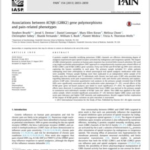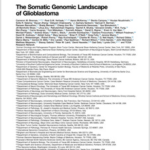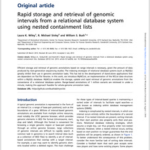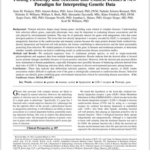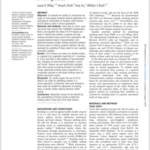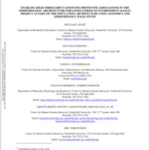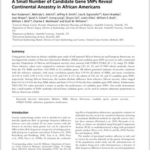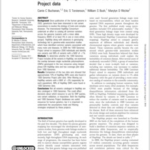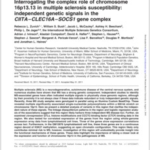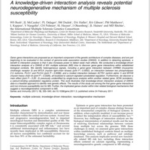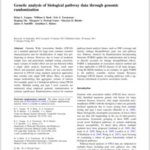Bruehl S, Denton JS, Lonergan D, Koran ME, Chont M, Sobey C, Fernando S, Bush WS, Mishra P, Thornton-Wells TA,. G-protein coupled inwardly rectifying potassium (GIRK) channels are effectors determining degree of analgesia experienced upon opioid receptor activation by endogenous and exogenous opioids. The impact of GIRK-related genetic variation on human pain responses has received […]
Category Archives: Publications
The somatic genomic landscape of glioblastoma.
Brennan CW, Verhaak RG, McKenna A, Campos B, Noushmehr H, Salama SR, Zheng S, Chakravarty D, Sanborn JZ, Berman SH, Beroukhim R, Bernard B, Wu CJ, Genovese G, Shmulevich I, Barnholtz-Sloan J, Zou L, Vegesna R, Shukla SA, Ciriello G, Yung WK, Zhang W, Sougnez C, Mikkelsen T, Aldape K, Bigner DD, Van Meir EG, […]
Rapid storage and retrieval of genomic intervals from a relational database system using nested containment lists.
Wiley LK, Sivley RM, Bush WS,. Efficient storage and retrieval of genomic annotations based on range intervals is necessary, given the amount of data produced by next-generation sequencing studies. The indexing strategies of relational database systems (such as MySQL) greatly inhibit their use in genomic annotation tasks. This has led to the development of stand-alone […]
Putting pleiotropy and selection into context defines a new paradigm for interpreting genetic data.
Predazzi IM, Rokas A, Deinard A, Schnetz-Boutaud N, Williams ND, Bush WS, Tacconelli A, Friedrich K, Fazio S, Novelli G, Haines JL, Sirugo G, Williams SM,. Natural selection shapes many human genes, including some related to complex diseases. Understanding how selection affects genes, especially pleiotropic ones, may be important in evaluating disease associations and the […]
ICD-9 tobacco use codes are effective identifiers of smoking status.
Wiley LK, Shah A, Xu H, Bush WS,. To evaluate the validity of, characterize the usage of, and propose potential research applications for International Classification of Diseases, Ninth Revision (ICD-9) tobacco codes in clinical populations.Using data on cancer cases and cancer-free controls from Vanderbilt’s biorepository, BioVU, we evaluated the utility of ICD-9 tobacco use codes […]
Characterization of the Metabochip in diverse populations from the International HapMap Project in the Epidemiologic Architecture for Genes Linked to Environment (EAGLE) project.
Crawford DC, Goodloe R, Brown-Gentry K, Wilson S, Roberson J, Gillani NB, Ritchie MD, Dilks HH, Bush WS,. Genome-wide association studies (GWAS) have identified hundreds of genomic regions associated with common human disease and quantitative traits. A major research avenue for mature genotype-phenotype associations is the identification of the true risk or functional variant for […]
Enabling high-throughput genotype-phenotype associations in the Epidemiologic Architecture for Genes Linked to Environment (EAGLE) project as part of the Population Architecture using Genomics and Epidemiology (PAGE) study.
Bush WS, Boston J, Pendergrass SA, Dumitrescu L, Goodloe R, Brown-Gentry K, Wilson S, McClellan B, Torstenson E, Basford MA, Spencer KL, Ritchie MD, Crawford DC,. Genetic association studies have rapidly become a major tool for identifying the genetic basis of common human diseases. The advent of cost-effective genotyping coupled with large collections of samples […]
A small number of candidate gene SNPs reveal continental ancestry in African Americans.
Kodaman N, Aldrich MC, Smith JR, Signorello LB, Bradley K, Breyer J, Cohen SS, Long J, Cai Q, Giles J, Bush WS, Blot WJ, Matthews CE, Williams SM,. Using genetic data from an obesity candidate gene study of self-reported African Americans and European Americans, we investigated the number of Ancestry Informative Markers (AIMs) and candidate […]
A comparison of cataloged variation between International HapMap Consortium and 1000 Genomes Project data.
Buchanan CC, Torstenson ES, Bush WS, Ritchie MD,. Since publication of the human genome in 2003, geneticists have been interested in risk variant associations to resolve the etiology of traits and complex diseases. The International HapMap Consortium undertook an effort to catalog all common variation across the genome (variants with a minor allele frequency (MAF) […]
Interrogating the complex role of chromosome 16p13.13 in multiple sclerosis susceptibility: independent genetic signals in the CIITA-CLEC16A-SOCS1 gene complex.
Zuvich RL, Bush WS, McCauley JL, Beecham AH, De Jager PL, , Ivinson AJ, Compston A, Hafler DA, Hauser SL, Sawcer SJ, Pericak-Vance MA, Barcellos LF, Mortlock DP, Haines JL,. Multiple sclerosis (MS) is a neurodegenerative, autoimmune disease of the central nervous system, and numerous studies have shown that MS has a strong genetic component. […]
A knowledge-driven interaction analysis reveals potential neurodegenerative mechanism of multiple sclerosis susceptibility.
Bush WS, McCauley JL, DeJager PL, Dudek SM, Hafler DA, Gibson RA, Matthews PM, Kappos L, Naegelin Y, Polman CH, Hauser SL, Oksenberg J, Haines JL, Ritchie MD, ,. Gene-gene interactions are proposed as an important component of the genetic architecture of complex diseases, and are just beginning to be evaluated in the context of […]
Genetic analysis of biological pathway data through genomic randomization.
Yaspan BL, Bush WS, Torstenson ES, Ma D, Pericak-Vance MA, Ritchie MD, Sutcliffe JS, Haines JL,. Genome Wide Association Studies (GWAS) are a standard approach for large-scale common variation characterization and for identification of single loci predisposing to disease. However, due to issues of moderate sample sizes and particularly multiple testing correction, many variants of […]

